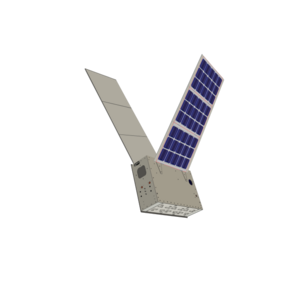Team Miles
 | |
| Mission type | Technology demonstration |
|---|---|
| Website | team |
| Mission duration | 2 years and 17 days (in orbit) |
| Spacecraft properties | |
| Spacecraft | Team Miles |
| Spacecraft type | CubeSat |
| Bus | 6U CubeSat |
| Manufacturer | Fluid and Reason, LLC. |
| Launch mass | 14 kg (31 lb) |
| Dimensions | 10 cm × 20 cm × 30 cm |
| Start of mission | |
| Launch date | 16 November 2022, 06:47:44 UTC[1] |
| Rocket | SLS Block 1 |
| Launch site | KSC, LC-39B |
| Contractor | NASA |
| Orbital parameters | |
| Reference system | Heliocentric orbit |
| Flyby of Moon | |
| Transponders | |
| Band | S-band |
NASA CubeQuest Challenge | |
Team Miles was a 6U CubeSat that was to demonstrate navigation in deep space using innovative plasma thrusters. It was also to test a software-defined radio operating in the S-band for communications from about 4 million kilometers from Earth. Team Miles was one of ten CubeSats launched with the Artemis 1 mission into a heliocentric orbit in cislunar space on the maiden flight of the Space Launch System (SLS), that took place on 16 November 2022.[1][2] Team Miles was deployed but contact was not established with the spacecraft.[3]
Overview
[edit]| Parameter | Units/performance |
|---|---|
| Thrust | 5 mN |
| Specific impulse (Isp) | 760 seconds |
| Impulse | 7456 N seconds |
| Power | 22 watts |
| Wet mass | 1.5 kg |
| Propellant mass | 1 kg |
| Propellant | Solid iodine |
| Thrust:Mass | 3.3 mN/kg |
| Impulse:Power | 338 N seconds/watt |
| Delta-V 12 kg craft | 649 m/s |
The spacecraft, a 6-Unit CubeSat — measuring 10 cm × 20 cm × 30 cm — was designed and is being developed by a non-profit group of fifteen citizen scientists and engineers (Fluid and Reason, LLC) based at Tampa, Florida.[4][5][6] Since the Team Miles won the first place at CubeQuest Challenge for the selection process,[7] Fluid and Reason, LLC stroke partnerships and became Miles Space, a commercial endeavor to further develop the technology and intellectual property that has come out of the design process.[4]
Propulsion
[edit]Wesley Faler, who leads Fluid and Reason, LLC., is the inventor of the ion thruster to be used, which he calls ConstantQ Model H.[8][4] It is a form of electric propulsion for spacecraft. The engine is a hybrid plasma and laser thruster that uses ionized iodine as propellant.[9][6] The Model H system includes 4 thruster heads which are canted, allowing for both primary propulsion and attitude control (orientation) without the use of moving parts.[8][10] The goal within the CubeQuest Challenge is to travel 4 million kilometers, but the team will attempt to go as far as 96 million kilometers before the end of the mission.[4]
Radio
[edit]The spacecraft will use the USRP B200mini, a software-defined radio operating in the S band for communications from about 4 million kilometers from Earth.[11]
See also
[edit]- Near-Earth Asteroid Scout by NASA was a solar sail spacecraft that was planned to encounter a near-Earth asteroid (mission failure)
- BioSentinel is an astrobiology mission
- LunIR by Lockheed Martin Space
- Lunar IceCube, by the Morehead State University
- CubeSat for Solar Particles (CuSP)
- Lunar Polar Hydrogen Mapper (LunaH-Map), designed by the Arizona State University
- EQUULEUS, submitted by JAXA and the University of Tokyo
- OMOTENASHI, submitted by JAXA, was a lunar lander (mission failure)
- ArgoMoon, designed by Argotec and coordinated by Italian Space Agency (ASI)
- Team Miles, by Fluid and Reason LLC, Tampa, Florida
- The 3 CubeSat missions removed from Artemis 1
- Lunar Flashlight will map exposed water ice on the Moon
- Cislunar Explorers, Cornell University, Ithaca, New York
- Earth Escape Explorer (CU-E3), University of Colorado Boulder
References
[edit]- ^ a b Roulette, Joey; Gorman, Steve (16 November 2022). "NASA's next-generation Artemis mission heads to moon on debut test flight". Reuters. Retrieved 16 November 2022.
- ^ Clark, Stephen (12 October 2021). "Adapter structure with 10 CubeSats installed on top of Artemis moon rocket". Spaceflight Now. Retrieved 22 October 2021.
- ^ "Team Miles". NASA Space Science Coordinated Archive. Retrieved 5 July 2023.
- ^ a b c d "Cube Quest Challenge Spotlight: Team Miles". Space Daily. 19 May 2017. Retrieved 10 March 2021.
- ^ Jennifer Harbaugh (18 May 2017). "Cube Quest Challenge Spotlight: Team Miles". NASA. Retrieved 10 March 2021.
 This article incorporates text from this source, which is in the public domain.
This article incorporates text from this source, which is in the public domain.
- ^ a b Jeremy S. Cook (30 August 2017). "The Miles CubeSat Might Be the Next Satellite Sent to Mars". Tampa Bay Times. Retrieved 10 March 2021.
- ^ Roman, Monsi C.; Kim, Tony; Sudnik, Janet; Cylar, Rosalind; Porter, Molly; Sivak, Amy; Cavanaugh, Dominique; Krome, Kim (12–14 September 2017). "Centennial Challenges Program Overview: How NASA Successfully Involves the General Public in the Solving of Current Technology Gaps". AIAA SPACE and Astronautics Forum and Exposition. Orlando, Florida: AIAA Space and Astronautics Forum and Exposition. doi:10.2514/6.2017-5159. hdl:2060/20170011238. ISBN 978-1-62410-483-1. Retrieved 10 March 2021.
- ^ a b "ConstantQ Spacecraft Propulsion". Fluid and Reason, LLC. 2017. Retrieved 10 March 2021.
- ^ Lloyd Sowers (12 May 2017). "Tampa team enters new Space Race with cube satellite". FOX13 Tampa Bay. Retrieved 10 March 2021.
- ^ "ConstantQ™ Thruster". Miles Space. 2017. Retrieved 10 March 2021.
- ^ Scott Schaire (2018). "Investigation into New Ground Based Communications Service Offerings in Response to SmallSat Trends". 32nd Annual AIAA/USU Conference on Small Satellites Document SSC18-SI-07. Retrieved 10 March 2021.
